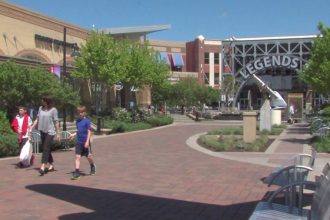California’s Legislature has approved a slate of policies aimed at curbing high and rising electricity costs, involving everything from short-term relief for high summertime utility bills to public financing of transmission grids — a big accomplishment in the waning days of the session.
The affordability measures emerged as part of a sprawling energy and climate package negotiated by legislative leaders and Gov. Gavin Newsom’s office last week and passed by lawmakers Saturday. Newsom, a Democrat, now has until Oct. 12 to sign the bills into law.
“It’s just a massive end of session,” said state Sen. Josh Becker, a Democrat whose bill, SB 254, was included in the package. “We had all these planes in the air. Are they all going to crash, or are they going to land?”
Becker hopes the provisions in SB 254 will contain rapidly rising costs for the state’s three biggest utilities — Pacific Gas & Electric, Southern California Edison, and San Diego Gas & Electric — which are in turn driving up rates for their customers. Those residents now pay roughly twice the U.S. average for their power, and nearly one in five are behind on paying their energy bills.
“Energy affordability was understood to be one of the top issues the Legislature needed to act on, due to massive rate increases and widespread customer outrage,” said Matthew Freedman, staff attorney at The Utility Reform Network, a consumer advocacy group that supported SB 254.
Among other things, that legislation aims to rein in how much utilities spend hardening their grids to reduce the risk of sparking wildfires, a major factor in cost increases. To that end, the bill would prohibit utilities from earning profits on some of the investments they make in wildfire-related upgrades.
It would also create a new “transmission accelerator” that enables utilities to use public financing to expand the state’s high-voltage grid rather than recoup those expenditures by charging customers. Those savings will take longer to kick in but could add up to billions of dollars a year, said Sam Uden, managing director of Net-Zero California, an advocacy group that cowrote a report last year examining how much utilities could save by relying on public financing.
“There’s a strategic role for public-sector investment to drive the clean energy transition,” he said. “We see this transmission financing as an embodiment of that viewpoint.”
Cutting the cost of California’s power grid
SB 254 ended up as a 136-page document with a multitude of energy and climate provisions, Becker told Canary Media last week. But he highlighted one set of key cost-containment measures that the utilities had particularly resisted.
Utilities typically earn a profit by receiving a return on the investments they make in grid upkeep. Now, though, California’s big three utilities will have to finance a portion of what they spend hardening their grids via bonds — a process known as securitization.
Utilities “were kicking and screaming on that,” Becker said.
The amount to be financed through bonds was initially set to be $15 billion for all three utilities. But Freedman suggested that the utilities might have used their political clout last week to negotiate the final securitization requirement down to $6 billion, which is “a pretty big reduction,” he said.
Regardless, securitizing a portion of the growing grid-hardening costs will reduce pressure on utilities to increase rates in the future, said Merrian Borgeson, California policy director for climate and energy for the Natural Resources Defense Council, which supported the legislation. “I don’t know what the rates are going to be next year, but they’ll be lower,” she said.
Enabling public financing of transmission projects could deliver even more savings over time, Borgeson said. The “transmission accelerator” created by SB 254 for that purpose would be based out of the Governor’s Office of Business and Economic Development (GO-Biz). That entity would be authorized to pool state funds drawn from California’s cap-and-trade program and from a climate bond passed last year to lower the cost of capital for transmission projects.
The California Independent System Operator, which manages the state’s grid, estimates that California must invest between $46 billion and $63 billion into transmission over the next 20 years to meet its goal of achieving a carbon-free grid by 2045. Using public money to offset a portion of utilities’ capital spending on those projects could cut the costs of the currently planned long-range transmission buildout by more than half, saving customers as much as $3 billion a year, according to an October report from Net-Zero California and the Clean Air Task Force.
Just how much money could be saved will depend on how the accelerator structures its public-private financing, Freedman said. “SB 254 leaves open a range of possible outcomes on this front,” he added. “It depends on the ambitiousness of the implementation by this and future governors.”
Cap-and-trade climate credit offers fast bill relief
The final days of this year’s session also saw lawmakers reauthorize the state’s decade-old cap-and-trade program, an initiative to reduce greenhouse gas emissions that was set to expire in 2030. AB 1207 and SB 840 would extend the program through 2045 and make a number of changes with significant implications for polluting industries, though regulators and lawmakers still need to work out the exact structures for executing the new rules, Borgeson said.
The bills also take an initial stab at reallocating funds raised by the cap-and-trade system to the myriad state programs and industry sectors jockeying for the money.
For example, one key affordability measure in AB 1207 institutes important changes to the “climate credit” now paid to utility customers out of funds collected from the cap-and-trade program.
Today, those credits are delivered to customers in twice-a-year lump-sum rebates. Under the new structure created by AB 1207, those rebates can be redirected to specifically help lower utility bills during summer months, when air conditioning drives up power consumption.
“Just think about the Central Valley,” Becker said during a virtual town-hall event in June, referring to a region of California that’s both hotter and poorer than the rest of the state. During summer heat waves, “it’s 100 degrees all day — and sometimes all night — in those areas. It’s literally a matter of life and death to keep the air conditioning on.”
AB 1207 will also redirect climate credits issued to gas utilities to support lowering summer electrical bills exclusively, through a process to be worked out by California utility regulators, Borgeson said. (Today, both gas utilities and electric utilities issue climate credits to their customers.)
That provision was strongly opposed by Sempra, the holding company of San Diego Gas & Electric and Southern California Gas Co., the state’s biggest gas-only utility. In an opposition letter, Sempra said the shift would create a “statewide subsidy requiring gas customers to fund bill relief for electric customers, worsening the high cost of living in California for millions of families.”
But climate advocates say the legislation aligns with California’s goal of shifting customers from using gas to using electricity. “This is a good idea, because it doesn’t need any more money,” Juliet Christian-Smith, Western states program director at the Union of Concerned Scientists, told Canary Media in July. Instead, “it’s redirecting money already in a pot to reduce electricity rates and enable the clean energy transition in a more affordable way.”









